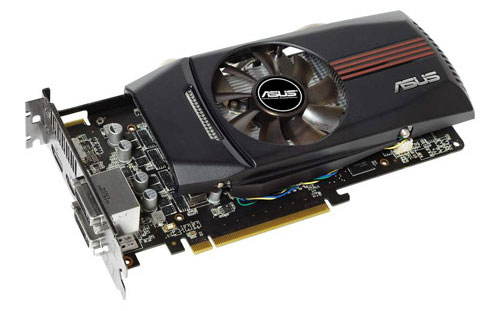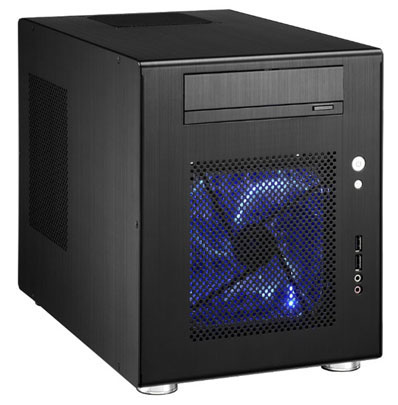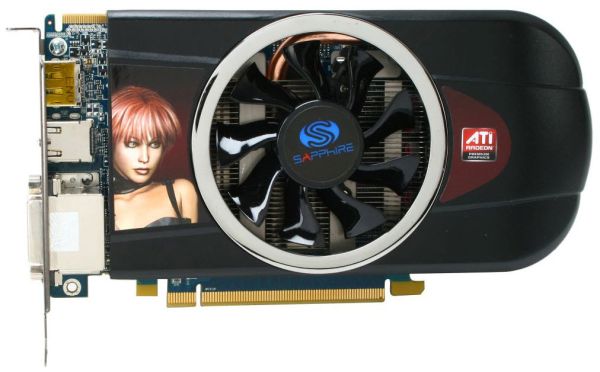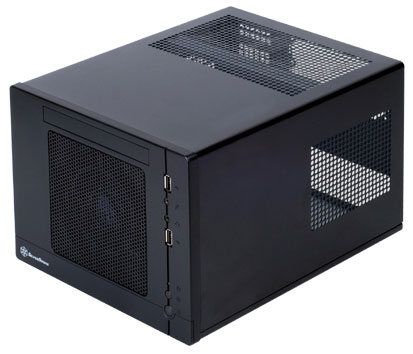Small Form Factor Buyers’ Guide
by Zach Throckmorton on May 25, 2011 10:30 AM ESTIntel Gaming SFF
Gaming rigs, with powerful CPUs and discrete GPUs, tend to produce more heat than standard desktops and HTPCs. Cramming the most power hungry components into a small space poses problems—problems that many newer SFF chassis obviate by getting a little bigger. Intel’s new Sandy Bridge CPUs are remarkably powerful while using relatively little juice. Similarly, AMD (ATI) GPUs tend to use less power under load than their NVIDIA competitors. Combine the two and it’s possible to assemble a nearly bleeding edge gaming rig in a slightly larger (13.6” x 9” x 10.8”) SFF system—and no, we aren’t going to put together a dual-GPU beast in the Silverstone FT03 chassis for this build, even if that is an option.
| Intel Gaming SFF | |||
| Component | Description | Cost | Rebate |
| Case | Lian Li PC-Q08B | $101 | |
| PSU | Antec TruePower New TP-550 | $90 | |
| CPU | Intel Core i5-2500K (4x3.3GHz, 3.7GHz Turbo, 8MB L3) | $216 | |
| Motherboard | ASUS P8H61-I | $85 | |
| GPU | ASUS EAH6850 DC/2DIS/1GD5/V2 Radeon HD 6850 | $155 | -$20 |
| Memory | Patriot 4GB (2x2GB) PSD34G1333K | $40 | |
| HDD | Samsung SpinPoint F3 HD103JS 1TB | $61 | |
| DVDRW | LITE-ON DS-8A5S | $33 | |
| OS | Windows 7 Home Premium 64-bit OEM | $100 | |
| Total Price | $881 | $861 | |
Note: The differences in case, PSU, and other components affect the total price.
If you compare with the AMD build, look at just the CPU, motherboard, and RAM.
Our Intel gaming SFF starts with the Core i5-2500K, a CPU that’s easily capable of running all the latest games (with an appropriate GPU). It uses very little power at idle and is an all around excellent chip. While it’s not quite as potent as the Core i7-2600K (thanks to the lack of Hyper-Threading), it also dissipates less

heat, making it a perfect fit for an SFF. Besides, if you’re planning on gaming and you’ll only be using a single GPU, particularly at higher resolutions there’s very little advantage to getting a faster CPU.
The AMD Radeon HD 6850 is a good match for the i5-2500K. Like the CPU, the 6850 isn’t the fastest GPU, but it’s plenty powerful and capable of playing the latest titles at 1080p and high detail settings at acceptable framerates. The 6850 is slightly slower than the previous generation 5850 (10% or less on almost all benchmarks), but it uses less power and its power connectors are better positioned (on the side vs. on the end) for use in an SFF case. It’s also about the longest video card that will fit in a mini-ITX chassis. At 10.27” in length, it fits inside the Lian Li PC-Q08B with a small amount of breathing room.
Speaking of which, I absolutely love the PC-Q09B case. It’s  somewhat large for a mini-ITX SFF chassis, but its airflow and cooling potential are very good and it can accommodate multiple 3.5” hard drives as well as a standard optical drive and PSU. For this build, we recommend a 1TB Samsung SpinPoint F3 HDD. Once you start installing games, an SSD will quickly run out of space, though you can always go the SSD + HDD combination if you choose. (We’d recommend at least a 60GB SSD, just because games periodically store additional files on the C: drive.) If you have the money, you could also get a larger 120GB SSD for the OS and apps and install a handful of favorite titles there, with any others relegated to the HDD.
somewhat large for a mini-ITX SFF chassis, but its airflow and cooling potential are very good and it can accommodate multiple 3.5” hard drives as well as a standard optical drive and PSU. For this build, we recommend a 1TB Samsung SpinPoint F3 HDD. Once you start installing games, an SSD will quickly run out of space, though you can always go the SSD + HDD combination if you choose. (We’d recommend at least a 60GB SSD, just because games periodically store additional files on the C: drive.) If you have the money, you could also get a larger 120GB SSD for the OS and apps and install a handful of favorite titles there, with any others relegated to the HDD.
Wrapping up our Intel Gaming SFF, I find modular PSUs work best in the PC-Q08B, as cable management is easier because there are fewer cables immediately adjacent to the hard drive cage. The Antec TP-550 is 80 Plus Bronze certified and has a few fixed cables with the rest being modular. If you prefer an alternative, the Seasonic M12II 520W is fully modular and 80 Plus Bronze certified. Both PSUs are very good quality and are more than sufficient wattage to power the components we selected. Just to be clear, the Antec and Seasonic PSUs (as well as other modular PSUs) are a very tight fit against the top drive cage, but with some patience, they will work.
AMD Gaming SFF
Like the HTPC segment, AMD does not currently offer any CPUs that can compete with the Intel offerings in terms of both performance and power consumption. Instead, AMD relies on cost to remain competitive. This AMD gaming system is not as powerful as the Intel system, but it costs a lot less. Here’s what we selected for this build.
| AMD Gaming SFF | |||
| Component | Description | Cost | Rebate |
| Case | Silverstone Sugo SG05-B | $105 | |
| CPU | AMD Athlon II X3 450 (3x3.2GHz, 3x512K L2) | $76 | |
| Motherboard | ASUS M4A88T-I Deluxe | $125 | |
| GPU | Sapphire 100283-3L Radeon HD 5770 | $115 | -$20 |
| Memory | Patriot 4GB (2x2GB) PSD34G1066SK SO-DIMMs | $44 | |
| HDD | Western Digital Caviar Blue WD5000AAKS | $45 | |
| DVDRW | LITE-ON DS-8A5S | $33 | |
| OS | Windows 7 Home Premium 64-bit OEM | $100 | |
| Total Price | $643 | $623 | |
| AMD Gaming Alternatives (Downgrades) | |||
| CPU | AMD Athlon II X2 250 (2x3.0GHz, 2x1MB L2) | $61 | |
| GPU | Sapphire 100287VGAL Radeon HD 5670 | $70 | -$10 |
| Total Price with Downgrade | $583 | $573 | |
Note: The differences in case, PSU, and other components affect the total price.
If you compare with the Intel build, look at just the CPU, motherboard, and RAM.
AMD’s Athlon II X3 450 offers tremendous value for the budget-conscious gamer; it uses less power than its

Black Edition Phenom II and quad-core relatives and only costs $15 more than the dual-core X2 250 we’ve recommended twice now. Matched with a Radeon HD 5770, you’ve got a very capable gaming system. At less than $100 after rebate, the Radeon HD 5770 offers astonishing value to gamers on a budget. The 5770 may not seem like much compared to other desktop GPUs, but keep in mind that this venerable GPU would rank near the top of the mobile GPU heap—it has the same number of GPU cores and is clocked higher than the Mobility HD 5870. So if you’re curious about the gaming potential, it would be roughly equal to the GTX 460M notebooks we’ve looked at recently, at less than half the price.
The Silverstone Sugo SG05-B mini-ITX chassis includes an 80 Plus certified 300W PSU. This case doesn’t have quite the airflow  potential of the Lian Li recommended above, and it’s also noisier because of the plastic construction, but it’s still a very good case. It’s also smaller at 10.9” x 8.8” x 7”. The SG05-B can house one 2.5” SSD and one 3.5” HDD, but since this is a budget build, we’re going with one 500GB Western Digital Caviar Blue mechanical HDD to keep costs down. As always, you can go with a larger capacity hard drive if necessary, and you can certainly add an SSD later if you’re interested. The case also supports a slim optical drive, so we chose a DVDRW to fill that role.
potential of the Lian Li recommended above, and it’s also noisier because of the plastic construction, but it’s still a very good case. It’s also smaller at 10.9” x 8.8” x 7”. The SG05-B can house one 2.5” SSD and one 3.5” HDD, but since this is a budget build, we’re going with one 500GB Western Digital Caviar Blue mechanical HDD to keep costs down. As always, you can go with a larger capacity hard drive if necessary, and you can certainly add an SSD later if you’re interested. The case also supports a slim optical drive, so we chose a DVDRW to fill that role.
Recommended Gaming SFF
Many popular games like StarCraft 2 and World of WarCraft have very modest hardware requirements for enjoyable gaming, especially at lower resolutions and/or detail settings. You could shave an additional $50 or so off the cost of the AMD system by using an Athlon II X2 250 CPU and Radeon HD 5670 GPU instead of the Athlon II X3 450 and Radeon HD 5770. You can see how the Athlon II X3 450 compares with Athlon II X2 255 in our CPU Bench; the 255 is about 3% faster than the 250, so you’re not missing out on much. Similarly, you can see how the 5770 compares to the 5670 in our 5670 review. The 6850 is quite a bit faster, of course, so if you can spare the extra $40 the ASUS 6850 in the Intel system will prove beneficial.
Our SFF Gaming rigs represent opposite ends of the budget spectrum, with the Intel system costing almost 50% more than the AMD system. The Intel system is certainly more capable, but if we remove all the other component differences from the table, the actual cost for the Intel SFF (CPU, motherboard, and RAM) is just under $100. If you only have a modest budget, the AMD system will suffice—you can also see how the two CPUs stack up in our CPU Bench. The AMD CPU may be inferior to the Intel CPU, but pay particular attention to the gaming performance, where the AMD triple core chip still turns out acceptable frame rates. Likewise, the Radeon HD 5770 isn’t as powerful as the Radeon HD 6850, but as you can see in GPU Bench, the cheaper GPU is still quite capable.










71 Comments
View All Comments
Gigantopithecus - Wednesday, May 25, 2011 - link
I completely agree, which is why I clearly stated "AMD’s Zacate platform (discussed in our last guide) is far less powerful than an i3-2100T system, but keep in mind that it is sufficient for most HTPC tasks."That is, already covered.
MrTeal - Wednesday, May 25, 2011 - link
As of yesterday Intel released the new Sandy Bridge Pentium chips, and Newegg has stock on at least the G620. The 620 might not be that appealing, but the G620T looks identical to the i3-2100T other than the 300MHz drop in CPU clock. For $50 less, it might be a pretty good downgrade.beginner99 - Thursday, May 26, 2011 - link
Yeah just saw them too. The G620T looks really nice for a NAS or HTPC. Extra CPU power compared to zacate can be useful in a NAS (RAID). Also Zacate MBs are pretty expensive where I live especially the ones with a usable amount of SATA ports (more than 4) meaning price wise a G620T won't cost much more.For a NAS the main problem is a decent case. This mean small but space for at least 4 hdds. Chenbro ES34169 looks cool but very expensive...
max40watt - Wednesday, May 25, 2011 - link
I suppose this is more in line with the Nettop article, but I built a delightful mini itx AMD Fusion e-350 based desktop in an old NES console a little while back. I've been using it mostly for htpc use (netflix and hulu over boxee software controlled via an iphone) but it's also proven to be fine for light gaming.I was worried about the heat inside of the Nintendo, but so far it doesn't seem to be a problem.
http://bit.ly/ithm17
Drag0nFire - Wednesday, May 25, 2011 - link
http://www.silentpcreview.com/intel-2100t-2400sAvlor - Wednesday, May 25, 2011 - link
Another great case for small form factor PCs in CoolerMaster Elite 100. It looks ok-ish, provides reasonable options for storage and will accommodate mATX boards despite being similar in size to that by Foxconn.Aikouka - Wednesday, May 25, 2011 - link
Zach, I recently rebuilt my server with a Core i3-2100t in an ASRock P67 Extreme6 motherboard. I actually used the stock heatsink/fan (HSF), which I normally don't do. I figured that it couldn't be too bad, right? I knew it'd probably be a little warmer. However, what I was very surprised about is how noisy that stock HSF is. I can literally hear my server from a room away, but my HTPC (Core i3 540) using a Thermaltake SlimX3 is fairly quiet (still audible within a few feet).To be fair... I'm not 100% certain that it's only the stock HSF's fault and not the motherboard doing a poor power management job. I told the motherboard to allow the CPU to go up to 50C, but it seems to never get that high, which makes me think it's not reducing the power properly.
Gigantopithecus - Wednesday, May 25, 2011 - link
Bizarre! I wouldn't call the stock i3 HSF silent, but the one I have in my music box up in my loft is inaudible ~10ft away with music at lower volume settings. Something is up with either your particular HSF or your board's regulation of its juice. Also, remember to check basics like having the HSF plugged into the HSF header and not having the HSF plugged into the chassis fan header (with the case fan plugged into the HSF header). I've done that before. :pOnus - Wednesday, May 25, 2011 - link
I built a gamer in a PC-Q08R last year (slide show of build on YouTube under user "jtt283"). I also used a 550W Truepower New. The CPU is an i5-650, on an ECS H55H-I. Initially I used a HD4850, which exhausted its heat. I switched that for a GTX460, and noticed a definite (though not hazardous) increase in temps, that also increased CPU cooler noise but not intolerably. I would be perfectly willing to use an even more powerful GPU, but it would have to be another that exhausts its heat. The fact that it will mount more drives than the mobo has ports means I may very well repurpose this machine as a backup server for the other PCs in the house.Bobsy - Wednesday, May 25, 2011 - link
Hi, just wanted to say this is a great article. For people who do not work in the field (building computers all day long), it's a great starting point for more research if desired, or a great shortcut for someone who just wants to get the job done. Very professional and well written. Thanks.